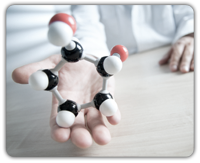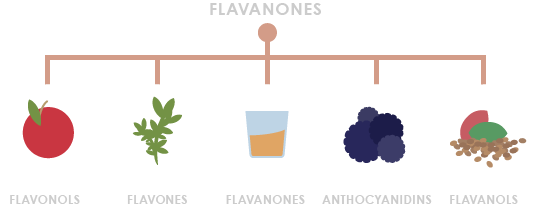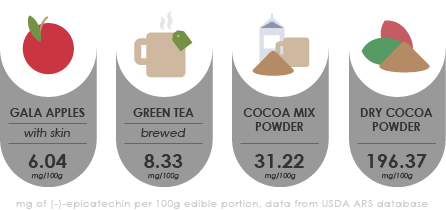
Flavanols are a group of compounds found in cocoa, tea, apples, and many other plant-based foods and beverages.
There is a growing body of evidence suggesting that a diet rich in flavanols can have a positive impact on cardiovascular health.
There is a growing body of evidence suggesting that a diet rich in flavanols can have a positive impact on cardiovascular health.
Flavanols: A Family of Compound
There are four primary forms of flavanols: (+)-epicatechin, (-)-epicatechin, (+)-catechin, (-)-catechin. These forms, called stereoisomers, are both naturally occurring and can be transformed from one form to another through food processing. Foods containing flavanols will have different types and mixtures of these isomers. The most common flavanols found in plant-based foods are (-)-epicatechin and (+)-catechin.

The importance of recognizing and understanding the differences between the content of these isomers in foods comes from the different biological effects each of the isomers may have in the human body. Research demonstrates that (-)-epicatechin is highly bioavailable (readily absorbed) as compared to the other isomers. Research to date has also indicated that the positive cardiovascular and blood vessel results shown have been attributed to (-)-epicatechin.
Flavanols can be linked together to form oligomeric flavanols, known as procyanidins. These linked (oligomeric) flavanols vary in size, and are typically referred to by the number of flavanols linked. For example, two linked flavanols are dimers, three linked flavanols are trimers, and so on.
Flavanols can be linked together to form oligomeric flavanols, known as procyanidins. These linked (oligomeric) flavanols vary in size, and are typically referred to by the number of flavanols linked. For example, two linked flavanols are dimers, three linked flavanols are trimers, and so on.
Flavanol-containing Foods
The flavanol profile of a food, meaning the amount and types of flavanols within that food, is unique. The flavanol profile of a food may determine the existence or lack of health benefits of a food. Therefore, research regarding intake of one food, such as cocoa, will contribute to the total knowledge of the role of flavanols in human health, but caution should be taken to not apply the specific effects observed in cocoa, for example, to other flavanol-containing foods.

As mentioned above, not all flavanols are equally absorbed or active in the human body. The figure above shows the amount of (-)-epicatechin in some examples of flavanol-containing foods.
Cocoa Flavanols

The term “cocoa flavanols” refers to the sum of the simple (monomeric) flavanols, including epicatechin, and to a lesser extent, catechin, as well as the oligomers from dimers (two linked flavanols) to decamers (ten linked flavanols).
The types and amount of flavanols found in the cocoa bean are changed and destroyed with standard processing techniques to make chocolate and other cocoa products. That is why it is important to remember to take caution when assuming that chocolate is a good source of flavanols.
To make sure you have accurate information – separate the facts from the fiction about cocoa flavanols.
Access more information on cocoa flavanols at Mars Center for Cocoa Health Science
The types and amount of flavanols found in the cocoa bean are changed and destroyed with standard processing techniques to make chocolate and other cocoa products. That is why it is important to remember to take caution when assuming that chocolate is a good source of flavanols.
To make sure you have accurate information – separate the facts from the fiction about cocoa flavanols.
Access more information on cocoa flavanols at Mars Center for Cocoa Health Science
The Science of Cocoa Flavanols
A significant body of published research has shown that consumption of cocoa flavanols can maintain healthy blood vessel function, thereby helping to support the health and function of the cardiovascular system. The cardiovascular system is an organ system consisting of primarily the blood vessels (arteries, veins, resistant vessels) and the heart that enables a healthy blood flow to transport nutrients (such as amino acids, glucose and electrolytes), oxygen, and carbon dioxide throughout the body.

The endothelium is the inner lining of the arterial blood vessels. An artery with healthy endothelium is able to dilate, or widen, when increased blood flow is needed. This process is known as flow-mediated dilation or FMD. FMD is dependent on the ability of the endothelium to release nitric oxide (NO), a compound produced by the body that causes the endothelium and the blood vessels to relax and contract to facilitate the healthy flow of blood, oxygen, and nutrients to the body as needed. Endothelial dysfunction is associated with high blood pressure and other cardiovascular diseases, and often increases with age.
Previous studies show that dietary consumption of cocoa flavanols play a role in the body’s production of nitric oxide, which is important to the health of the cardiovascular and circulatory system.
Many of these studies looked at people who had a history of heart disease or were at high risk for heart disease (vascular dysfunction). Further investigation is required in order to understand cocoa flavanols may impact the cardiovascular system in health adults and if cocoa flavanols can help people stay healthier, longer.
Previous studies show that dietary consumption of cocoa flavanols play a role in the body’s production of nitric oxide, which is important to the health of the cardiovascular and circulatory system.
Many of these studies looked at people who had a history of heart disease or were at high risk for heart disease (vascular dysfunction). Further investigation is required in order to understand cocoa flavanols may impact the cardiovascular system in health adults and if cocoa flavanols can help people stay healthier, longer.
